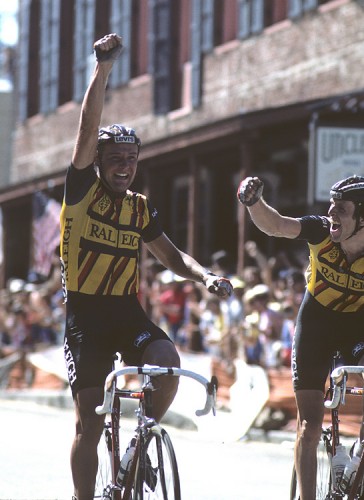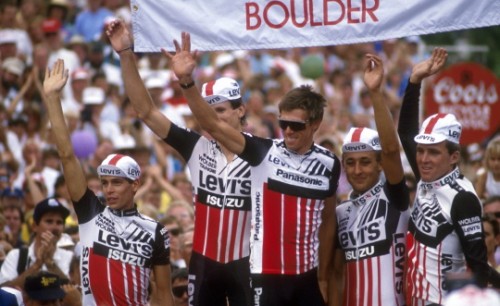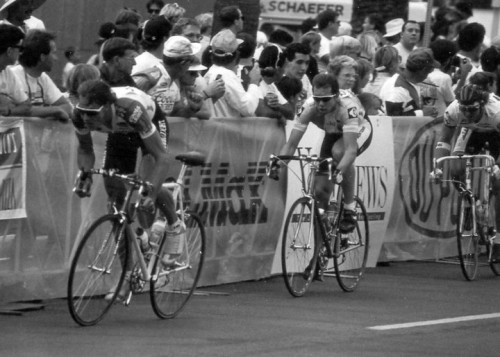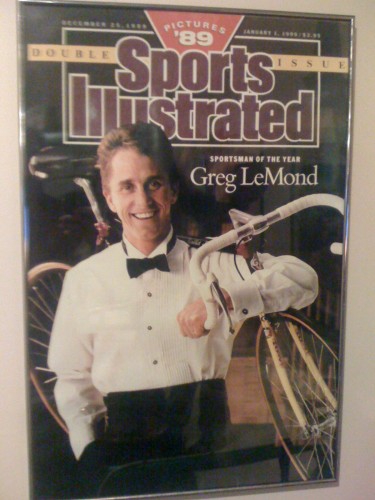When I was taking to Micah Rice at USAC a couple days ago, he was talking the corporate line. He asked me what year I raced my first cyclo-x Nationals. I told him I think it was 1979. And then he told me to compare that to Bend. The point he was trying to make is that the sport has grown dramatically. So, I’ve been thinking about it a couple days and I’d have to disagree.
I think the media coverage of the sport has become more accessible, but I’m not sure the sport has grown proportionally. At least not here in the US.
Obviously, MTB racing has taken a hit from its peak. There isn’t and won’t be a time when MTB racing is as popular as it was during the ’90’s. The MTB saved a lot of bicycle companies from going bankrupt. And, in the case of Schwinn, not participating in the sudden popularity destroyed a family business. The sport is a shell of what it used to be.
Cyclo-X is obviously more popular. Here in the US at least. But, it’s not popular enough to support full time professional racing. There are maybe 5 guys in the US that could make a living off exclusively off racing ‘cross. That isn’t enough to qualify it as a breakout segment of the sport.
And road racing. I don’t think it has progressed too much either. In the late ’80 we had just about the same schedule as is going on now. Instead of the Tour of California, there was the Dupont Race. Instead of Quiznos, it was the Coor’s Classic. And then just about every other weekend, there were races that had bigger price lists than just about any race now. A pretty good year for prize money back then was between $20-$30K. That was each member of our team. I very much doubt that many riders on PRO teams now make anywhere near that much in prize money.
And the races had more spectators. Many more. It is so easy to forget what it was like, hardly ever racing in front of less than a few thousand people.
I remember the photo from Nevada City a couple years ago with the Lance and Levi show. In 1984 when my team mate Greg Demgen won, there were more spectators. And a much bigger prize list. Greg won 2 ounces of gold and our $$$ splits were huge. That was 27 years ago.
I’m not complaining about where the sport has gone or how it got here. But, let’s not go patting ourselves on the back and think we’ve made it to the big leagues. I see in Europe where the “big leagues” take us and I am hesitant to want to go in that direction.










It’s pretty wild to see how big the crowds were at those races in the ’80s. Here in Chicago, at the Tour of Elk Grove and the sadly-defunct Chicago Criterium, the size of the crowds paled in comparison to those from back then. Elk Grove is one of the better paying stage race events in the US, yet, there was maybe 1,000 folks there for Sunday’s pro crit, with most of that crowd folks who had raced earlier in the day and had stuck around.
The same could be said for many of the UCI CX races in the States. Here you have events with world-class talent and the only people watching are people from the neighborhood, a few cyclists who had ridden over, and of course, racers and their families who had stuck around to see the pros.
No wonder it’s so hard to secure event sponsorships. If I owned a company and a race promoter came over and asked for money/in-kind services to help support his/her race and I saw the size of race crowds, I’d reply with a big no. What are the sponsors getting out of it?
CC may be a shell but I don’t think you can say that for mtb in general, it’s just different??
I wonder if there are more full time pro mtb’ers now than in the CC heyday?
http://www.flickr.com/photos/98124820@N00/4936536105/
I thought the mid to late 80s were the heyday for amateur road racing in the US. Tons of races, low entry fees, surprisingly good prize lists (even for us lesser riders). I would do 40-50 races/year and rarely drove more than 3 hours to get to a race (often a weekend of races). Now the entry fees are so high I debate the value of driving 2 hours for a 35-45 minute criterium.
Could it be that so many of the training plans that get marketed do not encourage alot of racing? They seem to try to get participants to focus on a few key races, not racing your way into shape.
Why should promoters put up huge money? It does not attract more racers.
I think that we all need to step back and ask ourselves how we can grow participation in our sport, and how can we foster young riders into becoming racers. That is the solution, not offering big payouts
Growth in competitive cycling is in independent federations, not USAC. USAC has lost Colorado and Oregon already. California, USAC’s biggest chunk of membership, is doing fewer USAC sanctioned races every year.
Compare Oregon’s Cross Crusade event with any given UCI sanctioned event in the U.S. Attendance for Cross Crusade was 1,500 riders! UCI events in the U.S. were nowhere near that. Nowhere.
The USCF of the bygone era you and I both recollect promoted grassroots competitive cycling. Weisel’s USAC does not promote grassroots cycling. I guess as long as USAC gets USOC funding they can look busy doing nothing for competitive cycling.
westylvin ,
According to an interview and subsequent comments on cyclingdirt.org, the number of Pro MTB riders in the U.S. that actually make a living, no regular job, no second season sponsor, is estimated at less than 10 in the U.S. The rest that call themselves ‘Pro’ get gear for manufacturer’s prices and wear the jersey they had to pay for, from said gear manufacturer.
Juniors/under 23’s and the rest are doing it with funds from the Bank of Mom and Dad.
My crackpot theory is the weekend warrior fields are too small to support a viable Pro category.
Dave Pelletier is cooking something up. I can’t wait!
Same thing for rodeo – the National Finals has seen the same payout for 20 years. Survivor has only paid $1M ever since it started. The BS “big” sports are the ones who get the $$ – I want to see a cyclist get a $20M signing bonus.
Racing costs too much in Kansas if you live outside the KC metro. I can’t afford to drive the 4 hrs to kc to race for 45 min. I see growth in these endurance events for the everyman, like Dirty Kanza, and similar privately run events. No membership, $40 buys a day full of riding, T-SHIRT, and swag. $40 racing a USCF event will get me half a license 4hrs from the starting line. I’ll just live vicariously through steve, and take my sons riding on the weekend here at home.
The Tour of Utah practically went right by my house last year but I did not go out and cheer since it was being led by two dopers, Levi and Mancebo. Why bother cheering them on? Funny thing is that I dedicated a decade of my life racing full time on the mtb in the 90’s and now I am disgusted with the state of doping in cycling. Love to ride and believe in the local race scene, but beyond that I dont trust the sport anymore, at this point its as real as WWF wrestling.
Steve, as usual, you’re insight is both informative and intriguing. You’re right, cycling in the US is essentially an amateur sport now, but why is that? Is it the doping scandals, Lance fatigue, a general lack of interest in “non-traditional” (i.e. not football, etc.) sports, or simply too many channels on cable TV? It seems anymore that the only people who think cycling is an interesting sport are those “in” the sport (a limited demographic certainly), but is that necessarily a “problem”? I’m not sure that it is. Are entry fees to high ? Yes, and it kinda sucks having to drive 2-3 hours to pay $40 to race, but I keep doing it every chance I get and so does every bike racer I know. Why? cuz racing a bike is fucking awesome and always will be. Pro or amatuer, big crowd or crickets, I’ll be there – and so will you.
@ David: I think a significant portion of entry fees come from race organizers having to pay for police when it was free or not required before. Also we now have race organizers who are doing it for a living rather than having an all volunteer race organization. Transponders and other ancillary benefits also add to costs. It also costs money to pay for officials whose main priority is giving shit to riders who wrinkle their numbers.
Personally I think Swag and T shirts are pretty stupid if they add to the cost of entry fees. If someone wants to buy an event t shirt, let them buy one from an authorized on site vendor.
Great post. Very good points. And the photos are priceless. Compare some of them to the (not-so-large) crowds at the Amgen Tour of California last year. Wow.